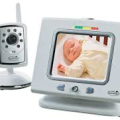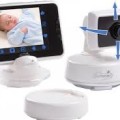The vast majority of baby monitors on the market today fall into the category of analog baby monitors or the category of digital baby monitors. Analog monitors tend to be cheaper, but may not be as feature-rich as digital monitors. Analog vs digital baby monitor, which is best for your home? Keep reading to find out.
 Introducing Video Baby Monitors
Introducing Video Baby Monitors
Video baby monitors can be analog or digital, depending on how signals are transmitted and received. All baby monitors include a transmitter and receiver, but not all monitors send the same type of signals between these components. Keep reading to learn about the differences between analog and digital transmission technology.
An Introduction to Analog Technology
The first baby monitors created years ago were analog. This technology turns audio or video feeds into one continuous signal and then transmits in the form of electronic pulses. The transmission is continuous, but the transfer is in small chunks that the receiver must put together to deliver the sound you hear on the other end.
An Introduction to Digital Technology
Most modern monitors created today use digital technology. This technology encrypts audio or video feeds and transmits as a series of codes all mixed up. This type of radio frequency is far more secure than analog, which does not encrypt what is being transmitted. Just like analog, the transmissions must be put in the correct order when received by on the other end to create a continuous feed.
Analog vs Digital Baby Monitor for Your Home?
There is no clear answer to this debate. Some homes function well with analog baby monitors, while other homes require the more advanced features and enhanced security of digital baby monitors. Remember that all monitors are transmitted through public airways, and that leaves them vulnerable to interference and interception.
If you live in a rural area with few close neighbors, then you may only need an analog monitor. If you live in an apartment building or in an area with neighbors close by, then you will need the extra security of a digital monitor that is less likely to cross signals with other baby monitors in the area. Having neighbors pick up your signals and vice versa is inconvenient and may invade your own privacy if they overhear intimate conversations. If this is a concern for you, then digital monitors are the safest option since the signals are encrypted.
Interference from wireless routers, cordless phones, and other devices can also be a problem. If your baby monitor shares a radio frequency with some of these devices in your own home or neighboring homes, then there could be interference. Analog and digital monitors are now made with multiple frequency channels. You can use these channels to limit the number of other devices competing for space on one frequency.
Ask yourself a few questions to make the final decision between analog and digital baby monitors:
1. How close are your neighbors? If they are close and you know some of them have small children, you may need a digital monitor to limit interference issues.
2. Do you have other wireless devices operating in your home? What frequencies do they use? If you can find a baby monitor that operates on a different frequency from wireless routers and cordless phones, you can limit interference.
3. What is your budget? If you are on a tight budget, you may be limited to an analog monitor. If you can afford to spend a bit more, then you will have more options in the digital market.
Once you decide between analog and digital baby monitors, you are ready for the exciting part: shopping! Make sure to read our comprehensive baby monitor reviews to find the models that will work best in your home. You want a secure, dependable monitor that you can rely on for that peace of mind you and your baby deserve.











 Facebook
Facebook Twitter
Twitter